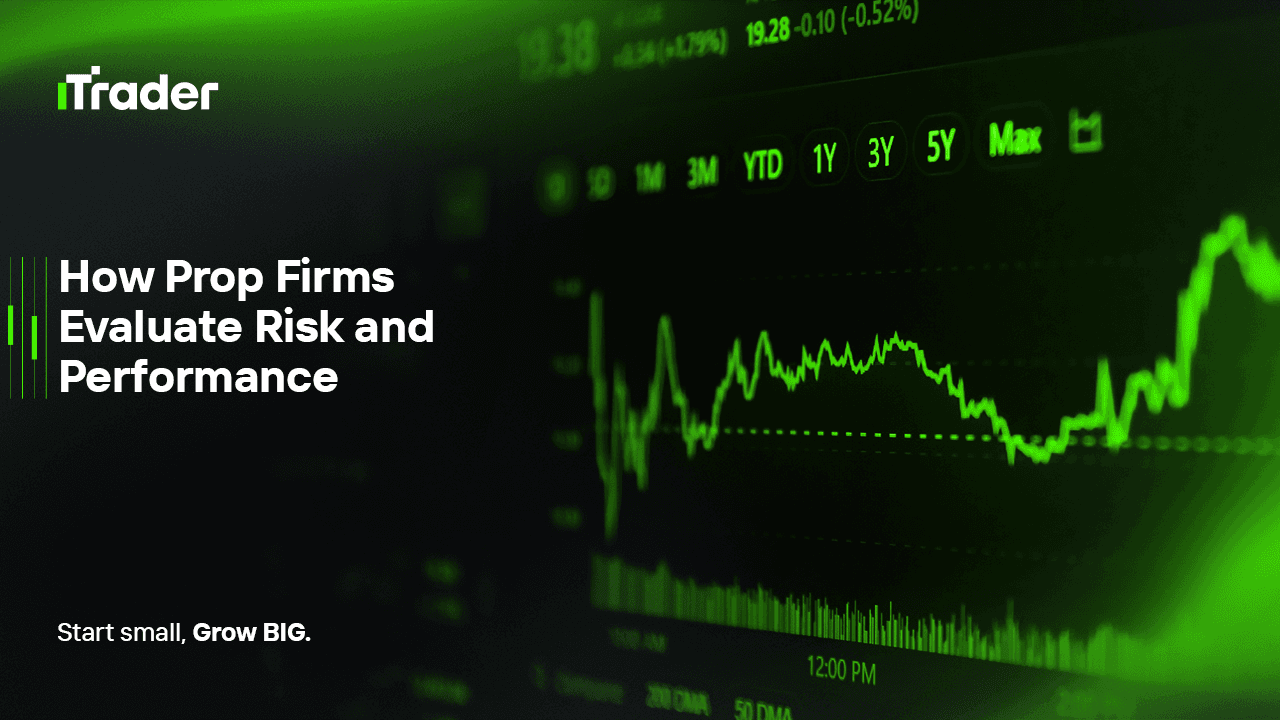2025-05-30
Proprietary trading firms (prop firms) play a pivotal role in the financial markets by deploying their own capital to trade various instruments, such as stocks, forex, commodities, and cryptocurrencies. For aspiring traders aiming to join these firms, understanding how they assess risk and performance is crucial.

This comprehensive guide delves into the methodologies prop firms employ to evaluate traders, offering insights into risk management, performance metrics, and the evaluation process.
Table of Contents
Proprietary trading firms are financial institutions that use their own capital to trade financial instruments, aiming to generate profits. Unlike traditional asset managers who trade on behalf of clients, prop firms take on the risk themselves. They often recruit talented traders, providing them with capital to trade, and in return, share the profits generated.
These firms are known for their rigorous selection processes, focusing on traders who can consistently manage risk and deliver strong performance. Understanding how prop firms evaluate risk and performance is essential for anyone aspiring to join their ranks.
Effective risk management is the cornerstone of successful trading. Prop firms prioritize risk control to protect their capital and ensure long-term profitability.
Establishing these parameters is foundational for effective risk management. Firms quantify risk limits, define metrics such as maximum drawdown, daily loss limits, and position size caps for traders, and regularly reassess these thresholds as markets and firm objectives evolve.
Prop firms utilize various metrics to assess and manage risk:
For instance, a trader with a $50,000 starting balance might face a 5% daily drawdown limit, meaning they cannot lose more than $2,500 in one day. If they incur a 10% overall drawdown, their balance must not drop below $45,000 at any point.
Beyond risk management, prop firms assess a trader's performance to ensure they can generate consistent profits.
These metrics evaluate the return of an investment relative to its risk:
These ratios help firms assess whether a trader's returns justify the risks taken.
Prop firms typically follow a structured evaluation process to assess potential traders.
During the evaluation phase, proprietary firms impose strict rules to mimic the discipline required in live trading. These rules vary slightly across firms, but typically include:
These rules are designed to simulate real-world trading discipline, ensuring only skilled and responsible traders move on to managing live capital.
Proprietary trading firms rely heavily on technology to evaluate and monitor risk. Here are some of the tools and systems commonly used:
Real-time monitoring is crucial for maintaining risk control across multiple traders and accounts. These systems provide:
These tools are often integrated into a firm’s internal trading platform or risk management software.
Firms also use advanced analytics platforms to gain deeper insights into trader behavior and risk exposure:
For example, a firm might use a dashboard to identify a trader who consistently risks more after losses—a red flag for poor emotional discipline.
Now that we understand how prop firms assess performance and risk, here are actionable tips for beginners looking to succeed:
A trading plan is your rulebook for entering and exiting trades, managing risk, and evaluating performance. Your plan should include:
Having a detailed plan reduces emotional decision-making and aligns your trading with the expectations of prop firms.
Many beginners believe they need to hit a home run to impress a prop firm. In reality, firms value:
Aim to show that you can follow rules, preserve capital, and make steady progress.
Keep a trading journal that documents:
Regular reviews of your journal can reveal patterns, strengths, and areas for improvement.
Most proprietary firms offer some form of feedback or analytics after the evaluation phase. Embrace it.
Traders who adapt quickly and effectively to feedback are often invited to manage larger accounts.
Proprietary trading firms offer an exciting opportunity for skilled traders to scale their trading operations using firm capital. But earning that opportunity means understanding exactly how these firms evaluate performance and manage risk.
By mastering the above, beginner traders can increase their chances of passing evaluations, earning funding, and building a sustainable trading career with a prop firm.
2025 Ай Трейдер Глобал ХХК | Компанийн бүртгэлийн дугаар: 15962
Ай Трейдер Глобал ХХК нь Комор улсын Анжуан арал дахь Мутсамуду хотын Хамчакод байрлалтай. Тус компани нь Коморын Үнэт Цаасны Хорооноос (Securities Commission of the Comoros) олгосон L15962/ITGL дугаартай тусгай зөвшөөрлийн хүрээнд үйл ажиллагаа явуулдаг.
Ай Трейдер Глобал ХХК нь “iTrader” нэрийн дор үйл ажиллагаа явуулдаг бөгөөд (Форекс) арилжааны үйл ажиллагаа явуулах эрхтэй. Компанийн лого, барааны тэмдэг, вэбсайт нь зөвхөн Ай Трейдер Глобал ХХК компанийн өмч юм.
Ай Трейдер Глобал ХХК -ийн охин компани болох : iTrader Global Pty Ltd, Австралийн компанийн бүртгэлийн дугаар (ACN): 686 857 198. Энэ компани нь Opheleo Holdings Pty Ltd компанийн албан ёсны төлөөлөгч бөгөөд Австралийн санхүүгийн үйлчилгээний төлөөлөгчийн дугаар: 001315037 -тай. Австралийн санхүүгийн үйлчилгээний лицензийн дугаар: 000224485 -тай Level 1, 256 Rundle St, Adelaide, SA 5000 хаягт байршдаг. Анхааруулга: Энэ байгууллага нь энэхүү вэбсайт дээр болон дамжуулан арилжаалагдаж буй санхүүгийн (арилжааны) хэрэгсэл нийлүүлэгч биш бөгөөд ямар нэгэн хариуцлага хүлээхгүй болно.
Эрсдэлийн сэрэмжлүүлэг: CFD арилжааны хөшүүргийн улмаас хөрөнгөө хурдан алдах өндөр эрсдэлтэй тул бүх хэрэглэгчдэд тохиромжгүй байдаг.
Фанд, CFD болон бусад өндөр xөшүүрэгтэй арилжаа нь хэрэглэгчээс нарийн төвөгтэй ойлголтуудын талаар тусгай мэдлэг шаарддаг. Хөшүүрэгтэй арилжаанд оролцогчдын 84.01% нь алдагдал хүлээдгийг судалгаанууд харуулдаг тул хөшүүрэгтэй арилжаанд орохоос өмнө хөрөнгөө алдах маш өндөр эрсдэлтэй болохыг анхаарна уу.
iTrader нь аливаа иргэн, хуулийн этгээдийн өмнө xөшүүрэгтэй арилжааны эрсдэл, алдагдал, бусад хохирлыг бүхэлд нь хариуцахгүй болохыг мэдэгдэж байна.
Энэхүү веб сайтын мэдээ, мэдээлэл нь зөвхөн мэдлэг түгээх зорилготой тул хэрэглэгч та бие даан шийдвэр гаргана уу.
Хязгаарлалт: iTrader нь вэбсайт болон үйлчилгээгээ тухайн орны хууль тогтоомж, дүрэм журмаар хориглосон орнуудад оршин суугчдад чиглүүлдэггүй. Хэрэв та энэхүү вэбсайтыг ашиглахыг хориглосон оронд байгаа бол вэбсайт болон үйлчилгээг ашиглахдаа тухайн орны хууль тогтоомжид нийцэж байгаа эсэхийг шалгах үүрэгтэй. iTrader нь вэбсайтынхаа мэдээлэл бүх оронд тохиромжтой эсэхийг баталгаажуулдаггүй.
Ай Трейдер Глобал ХХК нь зарим улс орны иргэдэд үйлчилгээ үзүүлэхээс татгалздаг болно. Жишээлбэл: АНУ, Орос, Бразил, Канада, Израйл, Иран.